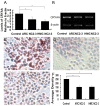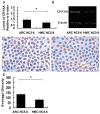Epigenetic regulation of αA-crystallin in high myopia-induced dark nuclear cataract
- PMID: 24312600
- PMCID: PMC3849391
- DOI: 10.1371/journal.pone.0081900
Epigenetic regulation of αA-crystallin in high myopia-induced dark nuclear cataract
Abstract
Purpose: To assess the etiology of early-onset dark nucleus in high-myopic patients and its relationship with the epigenetic regulation of αA-crystallin (CRYAA).
Methods: We reviewed clinical data from patients who underwent cataract surgery at our center in 2012. Lens epithelial samples were collected during capsulorhexis, whereas young lens epithelium was donated. Cataract type and severity were graded according to the Lens Opacity Classification System III (LOCS III). DNA methylation was analyzed by pyrosequencing the CpG islands of the CRYAA promoter in the following groups: Age-Related Cataract (ARC) Nuclear Color (NC) 2-3; High-Myopic Cataract (HMC) NC2-3; ARC NC5-6; HMC NC5-6; and in young lenses graded NC1. We analyzed CRYAA expression by real-time polymerase chain reaction (PCR), reverse transcription PCR, and immunohistochemistry.
Results: The odds ratio of dark nucleus in high-myopic patients was 5.16 (95% confidence interval: 3.98-6.69; p<0.001). CpG islands in lens epithelial CRYAA promoter in the HMC NC5-6 Group exhibited the highest methylation of all the groups, but no statistically significant differences were evident between the HMC NC2-3 and ARC NC2-3 Groups. Likewise, CRYAA mRNA and protein levels in the HMC NC5-6 Group were significantly lower than the ARC NC5-6 Group and high-myopic controls.
Conclusions: High myopia is a risk factor for dark nucleus. Downregulation of CRYAA via the hypermethylation of CpG islands in its promoter could underlie the earlier onset of dark nucleus in high-myopic patients.
Conflict of interest statement
Figures






References
-
- Saw SM, Gazzard G, Shih-Yen EC, Chua WH (2005) Myopia and associated pathological complications. Ophthalmic Physiol Opt 25: 381–391. - PubMed
-
- Pan CW, Wong TY, Lavanya R, Wu RY, Zheng YF, et al. (2011) Prevalence and risk factors for refractive errors in Indians: the Singapore Indian Eye Study (SINDI). Invest Ophthalmol Vis Sci 52: 3166–3173. - PubMed
-
- Lim R, Mitchell P, Cumming RG (1999) Refractive associations with cataract: the Blue Mountains Eye Study. Invest Ophthalmol Vis Sci 40: 3021–3026. - PubMed
-
- Wong TY, Klein BE, Klein R, Tomany SC, Lee KE (2001) Refractive errors and incident cataracts: the Beaver Dam Eye Study. Invest Ophthalmol Vis Sci 42: 1449–1454. - PubMed
MeSH terms
Substances
LinkOut - more resources
Full Text Sources
Other Literature Sources
Medical

